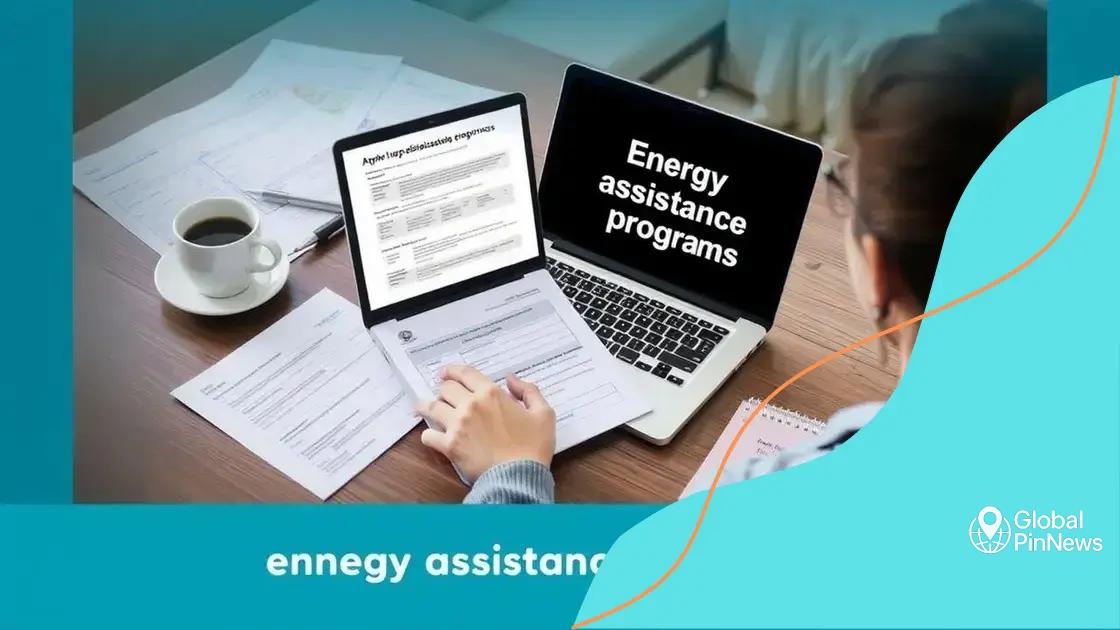Enrollment in energy assistance programs: what you need to know

Enrollment in energy assistance programs provides financial support for low-income households to help cover heating and cooling costs, along with resources for energy efficiency improvements.
Enrollment in energy assistance programs can be a lifesaver for many households struggling with energy costs. Have you ever wondered how such programs can ease your financial burden? In this article, we’ll dive into the details and guide you through the process.
Understanding energy assistance programs
Understanding energy assistance programs is essential for anyone looking to reduce their energy costs. These programs are designed to help low-income households manage their energy bills, ensuring that families have the resources they need to stay warm in winter and cool in summer.
Many people may be unaware of the specific types of assistance available, which is why we’ll break them down here.
Types of energy assistance programs
There are several types of energy assistance programs available, each catering to different needs. Some of the most common include:
- Low Income Home Energy Assistance Program (LIHEAP)
- Weatherization Assistance Program (WAP)
- State programs and local charities
- Utility company assistance programs
Each program serves a unique purpose, and understanding them helps applicants find the right fit for their situation.
How energy assistance works
Energy assistance programs often provide financial aid to help cover energy bills or offer services to make homes more energy-efficient. For instance, LIHEAP can offer one-time payments to help with heating and cooling costs. Additionally, programs like WAP focus on improving home insulation, which can lead to reduced energy consumption.
By participating in these programs, families not only receive immediate financial relief but also benefit from long-term savings on their energy bills.
In most cases, these programs are funded by a combination of federal, state, and local resources, making them available to those who need them most. Applications are often simple and can be done online or through local agencies.
Who qualifies for energy assistance?
Understanding who qualifies for energy assistance is crucial for those seeking help. Different programs have distinct eligibility requirements, yet they all aim to support low-income households.
Typically, to qualify, applicants must meet certain income guidelines set by the program. Households often need to provide proof of income for all members living in the home. This could include pay stubs, tax returns, or benefit statements.
General eligibility criteria
Most programs require applicants to meet a few common criteria:
- Income level below a specific threshold
- Citizenship or legal residency status
- Proof of residency in the utility service area
- Utility bill in the applicant’s name
These are the primary factors that determine who can receive assistance. Many programs also consider the number of people living in the home, which can affect the income limits.
Special considerations
Some applicants may have unique circumstances that can impact their eligibility. For example, elderly or disabled individuals may receive priority. Likewise, households with children may also be considered for additional support.
It’s essential to check with your local program for specific requirements, as each program may vary slightly. Many agencies have online resources to help determine eligibility and provide guidance throughout the application process.
How to enroll in energy assistance programs

Knowing how to enroll in energy assistance programs can make a big difference for families needing support. The enrollment process is usually straightforward and can often be completed online.
Before applying, it’s important to gather the necessary documents. This typically includes identification, proof of income, residency information, and your utility bill. Having these ready can speed up the process and help avoid delays.
Step-by-step enrollment process
To make the enrollment process easier, here are the typical steps to follow:
- Visit the official website of the energy assistance program.
- Look for the enrollment section or application link.
- Complete the online application form, making sure to provide accurate information.
- Submit the required documents as indicated.
After submission, applicants usually receive confirmation of their application. It’s essential to keep track of your application’s status, which can often be done online.
Assistance during the application
If you have questions during the application, many programs offer support through hotlines or in-person assistance at local offices. Don’t hesitate to reach out for help if needed.
Some programs may have deadlines for enrollment, so it’s best to act quickly. The sooner you begin the process, the sooner you could receive assistance with your energy bills.
Documents needed for enrollment
Gathering the right documents needed for enrollment in energy assistance programs is vital to ensure a smooth application process. Each program may have specific requirements, but there are common documents you should prepare.
Typically, applicants need to provide proof of identity, income, and residency. Collecting these documents ahead of time can make the process easier and faster.
Essential documents to prepare
Here are the key documents you will likely need:
- Identification such as a driver’s license or state ID
- Proof of income, which may include recent pay stubs or tax returns
- Utility bill to verify the account holder’s name
- Documentation of household members, like Social Security cards
Having these documents ready will help you complete the enrollment application without delays.
Additional documents possibly required
Some programs may ask for more information based on your specific situation. For example, if you are a senior citizen or disabled, you might need to provide additional paperwork to verify your status.
Always check with the specific program to understand what they require. This way, you can ensure you have everything you need when applying.
Benefits of participating in energy assistance programs
Participating in energy assistance programs offers numerous benefits that can significantly relieve financial stress for many families. These programs are designed not only to help reduce energy costs but also to improve overall quality of life.
One of the main advantages is that many programs provide financial assistance that can cover heating and cooling bills. This support can free up funds for other essential expenses like food and healthcare.
Additional benefits of energy assistance programs
Beyond direct financial help, there are several other benefits:
- Access to free or low-cost energy-saving services, like weatherization
- Priority during emergencies, such as extreme weather conditions
- Support for low-income families and individuals, ensuring basic needs are met
- Potential discounts on utility bills through participating providers
These programs can also help individuals learn about energy conservation practices, enabling them to reduce their bills in the long run. Education on energy efficiency can lead to smarter energy use and lower costs over time.
Long-term savings and security
By engaging with these programs, participants often find a pathway to long-term financial security. Not only do they gain immediate relief from high energy costs, but they also receive tools and knowledge that help them manage their energy use more effectively.
Ultimately, the combination of financial and educational assistance fosters a safer and more stable living environment, making these programs a vital resource for many in need.
FAQ – Frequently Asked Questions about Energy Assistance Programs
What are energy assistance programs?
Energy assistance programs help low-income households cover their heating and cooling costs. They provide financial aid and resources to improve energy efficiency.
Who is eligible for these programs?
Eligibility typically depends on income level, household size, and residency status. Many programs prioritize families with children, elderly, or individuals with disabilities.
What documents do I need to apply?
Commonly required documents include proof of income, identification, utility bills, and residency verification. It’s best to check specific requirements for each program.
How do I enroll in an energy assistance program?
To enroll, visit the program’s official website or contact local agencies. You usually need to fill out an application and submit required documents.
